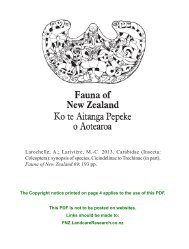PDF File, 693.8 KB - Landcare Research
PDF File, 693.8 KB - Landcare Research
PDF File, 693.8 KB - Landcare Research
Create successful ePaper yourself
Turn your PDF publications into a flip-book with our unique Google optimized e-Paper software.
6<br />
What’s New In Biological Control of Weeds<br />
Working under a tight time frame, we<br />
were not able to track down enough<br />
information to support or discount a<br />
number of hypotheses, such as the<br />
importance of host plant quality, genetic<br />
variability and susceptibility to secondary<br />
infection. Further research into the<br />
signifi cance of these factors is needed.<br />
However, our analysis did reveal that<br />
biocontrol impacts have, on average, been<br />
greater against biennial and perennial<br />
versus annual weeds, plants capable of<br />
vegetative reproduction versus those<br />
that reproduce solely by seed or spores,<br />
aquatic and wetland weeds versus<br />
terrestrial weeds, and plants that are not<br />
reported to be weedy in the native range<br />
versus those which are known to be<br />
weedy in the native range.<br />
Having sorted out the key factors,<br />
we developed a prototype scoringframework,<br />
and ran examples of South<br />
African and US biocontrol targets<br />
through it. “To validate our framework we<br />
compared our likely impact of biocontrol<br />
scores with the impact index scores we<br />
had calculated earlier and found that<br />
there was a good correlation between<br />
the two, so we were comfortable that<br />
our framework was on the right track,”<br />
explained Quent.<br />
We presented our preliminary framework<br />
at a workshop in Canberra to obtain<br />
feedback on the proposed scheme and<br />
seek further information about Australian<br />
weeds. Following the workshop we<br />
further refi ned the scoring system by<br />
incorporating data from Australian weed<br />
biocontrol programmes and undertaking<br />
a sensitivity analysis to ensure questions<br />
were weighted appropriately (see Table<br />
2). We then ran all 112 Australian weeds<br />
nominated as targets for biocontrol<br />
through the framework. Next we excluded<br />
species for which biocontrol programmes<br />
Table 1: Plant traits that might aff ect biocontrol success<br />
Hypothesis Our analysis<br />
Plants that are weeds in their native range<br />
are harder to control.<br />
Weeds with closely related non-target<br />
plants are harder to control.<br />
Annuals are more diffi cult to control than<br />
biennial and perennial weeds.<br />
Clonal weeds that reproduce solely<br />
vegetatively are easier to control.<br />
Terrestrial weeds are harder to control<br />
than aquatic/wetland weeds.<br />
Success is more likely for weeds that<br />
belong to a genus with many species (i.e.<br />
more agents available).<br />
Host plant quality aff ects success.<br />
Biocontrol is more diffi cult if there is<br />
diff erential susceptibility due to genetic<br />
variability (e.g. lantana).<br />
Plants that are susceptible to secondary<br />
infections are more susceptible to<br />
biocontrol.<br />
Success is greater against environmental<br />
weeds than agricultural weeds.<br />
were considered completed and prepared<br />
a prioritised list of the remaining 75<br />
species (see Table 3).<br />
While the framework appears to be<br />
robust and useful, as always there is room<br />
for improvement: “While we can now<br />
identify programmes that are likely to be<br />
‘winners’ or the most diffi cult targets, with<br />
a fair degree of confi dence, there are still<br />
many intermediate scoring weeds, where<br />
predicting success or failure is still a bit<br />
of a lottery,” said Quent. Our analysis only<br />
explains about half the variation in the<br />
Issue 48 May 2009<br />
There was some evidence from the USA<br />
to support this.<br />
No, but non-target attack on native<br />
plants was a minor consideration in<br />
the past. We consider this to be an<br />
important factor because many past<br />
programmes would not be able to<br />
proceed under today’s regulations.<br />
Yes for the USA, data not available for<br />
South Africa where only one annual<br />
weed has been targeted for biocontrol.<br />
There was evidence from South Africa<br />
to support this<br />
There was some evidence from South<br />
Africa and the USA to support this.<br />
No evidence was found to support this.<br />
Not enough information was available<br />
to assess this.<br />
This appears to be important, but there<br />
was not enough information available<br />
to assess this statistically.<br />
There was not enough information<br />
available to assess this.<br />
We did not attempt to assess this<br />
because many weeds do not fall neatly<br />
into one or other category.<br />
success of past biocontrol programmes. If<br />
we can identify further factors that aff ect<br />
biocontrol success and modify the scoring<br />
system accordingly, we should be able<br />
to make signifi cant improvements to the<br />
predictive power of the framework. For<br />
example, the relevance of criteria that<br />
authors have suggested are important,<br />
such as food quality, but which we were<br />
unable to include due to a lack of data<br />
should be investigated. For this reason, we<br />
have recommended that the framework<br />
is expanded and reviewed regularly and<br />
revised as more weed biocontrol impact
















